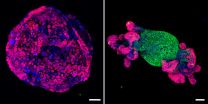(Press-News.org) PRINCETON, N.J.--Within the next two weeks, or soon after, the United States and five world powers hope to finalize a nuclear deal with Iran to limit its nuclear activities in exchange for a relaxing of international economic and financial sanctions. But what happens in 10 years when some of the key restrictions being discussed begin to phase out?
One of the biggest concerns is Iran's uranium enrichment program, which uses high-speed centrifuges to produce uranium enriched to a level appropriate for nuclear power reactor fuel. Enrichment plants like this can be quickly reconfigured to produce "weapon-grade" uranium.
One way to reduce this risk is by converting Iran's enrichment program from a national to a multinational enterprise, according to a policy report published in the journal Science by researchers from Princeton University's Program on Science and Global Security (SGS), based at the Woodrow Wilson School of Public and International Affairs.
"Reducing proliferation risks by ending national control over dangerous civilian nuclear activities is an important idea with a long history," said Alexander Glaser, one of the authors of the report and assistant professor of engineering and international affairs. "As civilian nuclear technology keeps spreading, multinational control may offer the only realistic way to stop the spread of nuclear weapons capability."
In their report, Glaser and co-authors Frank von Hippel, professor of public and international affairs, and Zia Mian, a research scholar at SGS, explain the special risk of modern centrifuge enrichment technology and how this risk increases dramatically with the number of centrifuges and the available uranium stockpile. Taken together, these factors determine the "breakout time" - the time it would take a country to acquire enough weapon-grade material for one nuclear bomb. Making sure that the breakout time is at least one year has been a key objective of the United States in talks with Iran.
The Princeton authors propose that Iran's neighbors and one or more members of the E3+3 (France, Germany and the United Kingdom, plus China, Russia and the United States, often called the P5+1) could purchase a share of Natanz, Iran's primary nuclear enrichment plant. This would give the world continued access to Iran's centrifuge program and confidence that it was being used only for peaceful purposes - in a way that goes beyond traditional international nuclear safeguards.
Because all of the E3+3 partners have expertise in uranium enrichment, they would not be required to share centrifuge technology but could be given full access to the plant without raising new proliferation concerns, the researchers write. To ensure even greater transparency, Middle Eastern countries could form a regional nuclear inspectorate, when politically appropriate, to supplement current international safeguards. "This would be similar to what Argentina and Brazil did after they both simultaneously gave up their nuclear weapon programs," von Hippel said.
"The nuclear deal with Iran and a multinational approach to uranium enrichment could be important steps toward a long-hoped-for nuclear weapon-free zone in the Middle East," said Mian, one of the authors of the report. "Achieving this goal would become easier if all the countries in the region accepted the same nuclear limitations as Iran and Israel gave up its nuclear weapons, something the international community has long demanded."
The policy report, "After the Iran deal: Toward multinational enrichment," was published in Science on June 18.
INFORMATION:
Well-practiced motor skills like riding a bike are extremely stable memories that can be effortlessly recalled after years or decades. In contrast, a new study publishing in PLOS Computational Biology shows that changes to motor skill memories occurring over the course of a single practice session are not immediately stable, according to researchers Andrew Brennan and Maurice Smith of Harvard University School of Engineering and Applied Science and Center for Brain Science.
We're all familiar with the old saying that you never forget how to ride a bike and perhaps personally ...
Chlamydia trachomatis is a formidable foe. It's the most common sexually transmitted pathogen, infecting more than 100 million people each year. In the developing world, chlamydial infection is the leading cause of preventable blindness. Around the world, it ranks as the number one cause of infertility and ectopic pregnancy.
Chlamydial infection ignites chronic inflammation, which scars mucosal surfaces such as eyelids, ovaries or fallopian tubes. Most people who carry the bacterium don't know it. Women with chlamydia are much more vulnerable to other sexually transmitted ...
To predict how a seasonal influenza epidemic will spread across the United States, one should focus more on the mobility of people than on their geographic proximity, a new study suggests.
PLOS Pathogens published the analysis of transportation data and flu cases conducted by Emory University biologists. Their results mark the first time genetic patterns for the spread of flu have been detected at the scale of the continental United States.
"We found that the spread of a flu epidemic is somewhat predictable by looking at transportation data, especially ground commuter ...
Baboons live in a strongly hierarchical society, but the big guys don't make all the decisions.
A new study from the University of California, Davis, reveals -- through GPS tracking -- that animals living in complex, stratified societies make some decisions democratically. The study breaks ground in how animal behavior data is collected.
The study is being published Friday (June 19) in Science.
"It's not necessarily the biggest alpha males that influence where groups go," said co-author Meg Crofoot, assistant professor of anthropology at UC Davis. "Our results illustrate ...
DNA from the 8,500-year-old skeleton of an adult man found in 1996, in Washington, is more closely related to Native American populations than to any other population in the world, according to an international collaborative study conducted by scientists at the University of Copenhagen and the Stanford University School of Medicine.
The finding challenges a 2014 study that concluded, based on anatomical data, that Kennewick Man was more related to indigenous Japanese or Polynesian peoples than to Native Americans. The study is likely to reignite a long-standing legal ...
NASA provided four different views of Tropical Depression Bill as it continued traveling through the south-central U.S. and into the Ohio Valley. NASA's Aqua and Terra satellite provided infrared and visible imagery while NASA/NOAA's GOES Project animated NOAA's GOES-East satellite imagery to show the storm's progression since landfall. The Global Precipitation Measurement or GPM core satellite also showed rainfall estimates and locations.
On June 18, the National Weather Service, Weather Prediction Center (NWS/WPC) noted that flood and flash flood watches and warnings ...
Kangaroos prefer to use one of their hands over the other for everyday tasks in much the same way that humans do, with one notable difference: generally speaking, kangaroos are lefties. The finding, reported in the Cell Press journal Current Biology on June 18--the first to consider handedness in wild kangaroos--challenges the notion that "true" handedness among mammals is a feature unique to primates.
"According to a special-assessment scale of handedness adopted for primates, kangaroos pulled down the highest grades," says Yegor Malashichev of Saint Petersburg State ...
Anti-cancer strategies generally involve killing off tumor cells. However, cancer cells may instead be coaxed to turn back into normal tissue simply by reactivating a single gene, according to a study published June 18th in the journal Cell. Researchers found that restoring normal levels of a human colorectal cancer gene in mice stopped tumor growth and re-established normal intestinal function within only 4 days. Remarkably, tumors were eliminated within 2 weeks, and signs of cancer were prevented months later. The findings provide proof of principle that restoring the ...
American scientists have discovered that a drug commonly used to treat osteoporosis in humans also stimulates the production of cells that control insulin balance in diabetic mice. While other compounds have been shown to have this effect, the drug (Denosumab) is already FDA approved and could more quickly move to clinical trials as a diabetes treatment. The research is published June 18 in Cell Metabolism.
Diabetes is a major health issue worldwide that arises due to a deficiency of insulin-producing beta cells in the pancreas. In type 1 diabetes, beta cells die from ...
Cutaneous melanoma, the most deadly form of skin cancer, is now believed to be divided into four distinct genomic subtypes, say researchers at The University of Texas MD Anderson Cancer Center, a finding that could prove valuable in the ever-increasing pursuit of personalized medicine.
As part of The Cancer Genome Atlas, researchers identified four melanoma subtypes: BRAF, RAS, NF1 and Triple-WT, which were defined by presence or absence of mutations from analysis of samples obtained from 331 patients. The five-year study resulted from an international collaboration of ...


